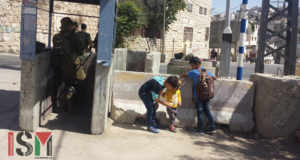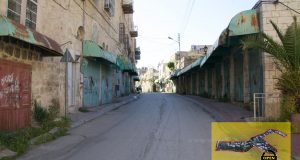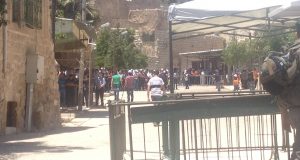1. Thirty Days Against Borders – Children of Nablus against the Occupation
by the Palestinian Body for Peace, Dialogue and Equality (HASM)
Sunday 14th of January
School children from Nablus dressed up like Native Americans will gather in a peaceful demonstration at Huwarra checkpoint. On the other side of the checkpoint, Israeli peace activists will be gathered to support their demonstration.
We are not demonstrating to end the Occupation together as no Israeli civilians are allowed to enter Nablus, and the children from Nablus will have great difficulties getting out through Huwarra Checkpoint.
Over four weekends in January and February, Palestinian, Israeli and international peace organizations will gather at both sides of Huwarra Checkpoint to protest against the regime of barriers which severely restricts movement in the West Bank. They will sing and play, have a photo exhibition and in other ways demonstrate for peace.
Nablus under siege
We are doing this as Nablus is the most imprisoned city in the West Bank. Since 2002 it has only been possible to enter through six checkpoints. It is even more difficult to exit. Men between 16 and 45 (it varies from day to day) can only exit their city with a special permit that can be obtained only outside Nablus. Almost nightly its citizens are the victims of violent military
raids and their lives have not been peaceful, or normal for years.
The people of Nablus are regarded as terrorists by the Occupying Forces who deny them their human rights and subject them to collective punishment.
Internal Palestinian political conflicts have resulted in large numbers of Palestinians refraining from participation in collective resistance against the Israeli Occupation. We support non-violent methods of resistance and cooperation between different Palestinian, Israeli and international groups. Until now there has not been a clear strategy to coordinate various peace activities to achieve justice for all.
The lack of progress towards peace has made the new generation of Palestinians disillusioned and made them lose faith in their abilities to improve their situation.
• This project expresses the will of most Palestinians and represents their rejection of the Occupation without sacrificing their children or themselves.
• We designed these activities to express our resistance to the Occupation in general and the closures around Nablus in particular
• We hope that people from all countries and organizations will support the children of Nablus in these peaceful demonstrations at Huwarra Checkpoint .
*******************************
2. Human Rights Defenders targetted in Hebron again
by ISM Hebron, December 31st
An international Human Rights Worker (HRW) was arrested by the IDF in the Hebron district of Tel Rumeida at 1:40 p.m today. He was accompanying five Palestinian men along Shuhada Street in their attempt to exercise their right to walk past the Beit Hadassah setlement as stipulated in a recent Israeli High Court ruling. Three Palestinian men succesfully crossed this boundary on Friday 29 December which has been off-limits to Palestinians for the last six years. To travel from the Bab Al Zawiye market district in the north of the city to the south, Hebronites have to either drive around, taking 15 minutes, or walk, which takes over an hour. The roads on this circuitous route are often clogged with traffic. Walking from Bab Al Zawiye down Shuhada street to the other side of the Old City takes around 10 minutes.
As the five men and the HRW reached the settlement, the soldier on duty stated that they were to wait to be “escorted” by his commander even though this condition is nowhere in the ruling which was shown to the soldiers. The commander was however in a meeting and only arrived 50 minutes later. By this time three of the five men had already left as it was raining heavily. The commander escorted the remaining two men down Shuhada Street as far as Gross Square, but stated that the HRW was not allowed to use this road. The HRW obeyed and followed the group from a pathway above the road, which is perfectly permissable.
The HRW reached the end of the pathway and was observing the Palestinian men who had passed through Shuhada Street succesfully with a IOF escort. A bypassing Jewish settler colonist who noticed the HRW stopped his car, rolled down his window and began shouting at the HRW in Hebrew. The HRW did not react to this in any way. The settler then put his car indicator on and began making a U-turn in order to approach the HRW. Being trapped, and fearing attack, the HRW ran onto Shuhada Street in the direction of the soldiers in the hope that this would deter the settler.
Upon reaching the group of soldiers the HRW immediately apologised to the commander and told him that he had only run down Shuhada Street because he was being threatened by a settler and sought protection from the soldiers. The commander refused to listen and ordered the HRW to stand and place his hands against the wall. The HRW was searched and his hands then tied together behind his back. He was then put into the back of an IOF Jeep and blindfolded. These actions of the IOF are illegal as they are not allowed to arrest internationals – according to Israeli law this has to be done by the border police.
After being driven around and waiting in the Jeep the HRW was taken to a police station where the blindfold was removed and plastic tie-wire cut from his wrists. He was then charged with “disobeying a soldier’s orders” and finally released at 4:00 p.m on condition that he not enter Shuhada Street again, or would be liable to pay a fine of NIS 2000.
After this HRW was arrested another nine Palestinians adults and four children waited for almost one hour in the rain to be allowed to walk down Shuhada Street. In this time they were all extensively searched. Whilst walking along the street two settler girls started throwing stones and hitting them. The police approached but didn’t do anythng and the Palestinians continued walking.
One Palestinian who had already had his ID checked and been searched, was being detained again on Shuhada street. Mary Baxter, the HRW who was arrested two weeks ago, asked the soldiers why he was being detained again. She was shouted at to move away and asked to show her passport. On doing this the soldiers snatched her passport from her hands and refused to return it. They also refused to let her shelter from the rain and cold for over half an hour. The police arrived to take Mary away in a police jeep to the police station where she was told she was charged with assaulting a police officer. She was however also told that she hadn’t been arrested but would be summoned to appear in court. Mary was released an hour later.
HRWs who spend an extended period of time in Tel Rumeida are regularly targetted by the police. This involves being detained and taken to the police station on trumped up charges before being released after a few hours.
*******************************
3. Bil’in Demo Cancelled by IOF Violence
by the ISM media team and IMEMC,
Officials and supporters of the Palestinian Fateh movement joined together with residents of Bil’in, as well as international and Israeli activists for the commemoration of the forty-second anniversary of the founding of the Fateh movement and a demonstration against Israel’s Annexation Wall.
Jabril Rajoub, of Fateh, commended the unanimity amongst Palestinians fostered within Bil’in, and cited the death of Yasser Arafat as significant catalyst toward the curent political crisis. The void left by Arafat, he said, combined with an absence of unified leadership, has led to endemic problems such as a lack of security, employment and such basic necessessities as food and education. Kais abu Leyla, also of Fateh, echoed the call for unity between Islamic and nationalist parties, to put an end to factionalism and restore a cohesive Palestinian resistance to the Occupation.
Muhammad Baraka, member of Knesset, condemed ongoing Palestinian infighting and called for an immediate cessation of factional violence, commending the village of Bil’in for the example it has shown.
Before commencing the march toward the Wall, featured speakers extended their thanks to
international and Israeli activists who have worked alongside the residents of Bil’in in their efforts against the Annexation Wall. The village has lost approximately 60% of its land, primarily agricultural, to the construction of the barrier and the illegal expansion of the Modin Illit settlement directly adjacent. Residents of Bil’in and their supporters have demonstrated and conducted non-violent direct action against the Wall every Friday for nearly two years.
Following the rally in the village center, over five hundred demonstrators marched toward an access gate to the Wall where Israeli Occupation Forces (IOF) awaited them. A much bolstered force accompanied the soldiers typically stationed in the area, possibly in advanced preparation of the well-publicized march and in the aftermath of Thursday’s Israeli invasion into Ramallah that claimed four Palestinian lives and left twenty wounded, several critically. A large contingent of Israeli Border Police indicated a preparedness to conduct mass arrests.
Israeli soldiers took positions at several locations along the expanse of the primary fence and almost immediately attacked the peaceful demonstration, though the majority of marchers had not yet arrived at the barrier. The IOF fired a vehicle-mounted water and tear gas cannon which some of the youth responded to by throwing stones.
The soldiers then began firing tear gas canisters indiscriminately into the crowd spread out over a large area as well as rubber-coated metal bullets and percussion grenades.
After the crowd had dispersed due to the massive amounts of tear gas used, the IOF pursued villagers well into a residential area of the village, firing continuously at the youth who were resisting with stones, with the water cannon and rubber-coated bullets.
Several Bil’in residents were injured, including at least one who was taken to the hospital for treatment and some other marchers with breathing difficulties suffered the effects of tear gas inhalation. An Israeli activist also received first aid after suffering burns from a tear gas canister.
For more information on the injured, please contact Abdullah at 054-725-8210:
Suleilman Khalid Khatub (17) shot with rubber-coated bullet in back
Wael Fahmi Nasser (29) shot with rubber-coated bullet in leg
Farahat Ibrahim Hashem (26) shot with rubber-coated bullet in leg
Hiyam Abed al Al (15) tear gas inhalation
Khaled Showkat al Khatib (20) shot with rubber-coated bullet in hand
Ashraf Muhammad Jamal al Khatib (26) shot with rubber-coated bullet in leg
Jonathan Pollak, Israel (25) tear gas canister burns to hand
Ahmad Issa Yasin (50) tear gas inhalation
For photos visit: https://www.palsolidarity.org/main/2007/01/05/bilin-05-01-07/
********************************
4. IOF block access to Shuhada Street, defying court order
by ISM Hebron, January 9th
Local Palestinian residents were yesterday prevented from walking down Shuhada Street, which cuts through the centre of Hebron. This is despite a recent High Court Order ruling that the closure of Shuhada Street to Palestinians for the past six years was a ‘mistake’ and their recent access to this street.
At 10am four local Palestinians accompanied by Israeli activists and an Israeli Channel 1 TV crew walked down Shuhada Street with copies of the High Court Order. They were stopped outside the Beit Hadassah colony by a large group of soldiers and some border police officers. An IOF Commander claimed the existence of a new military order forbidding access to Shuhada Street for Palestinians, but refused to show the new order. On Channel 1 later, an IOF spokesperson denied the existence of this new order and said it would be ‘investigated’. The Commander threatened to arrest the Palestinians if they didn’t leave within five minutes but failed to carry out this threat as the local residents negotiated unsuccessfully for over half an hour for access to Shuhada Street.
During this time settler colonists came out of Beit Hadassah and started to call the Palestinians names. A settler representative rejected the pleas of the Palestinians for them to live in peace and walk together down Shuhada Street, claiming that Shuhada Street was exclusively for Jews.
International observers from different groups had gathered on the path that leads to the Palestinian Qurtuba girls school overlooking Shuhada Street to document the events. Three soldiers approached them and asked them to move on but failed to take action when they stayed.
For photos visit: https://www.palsolidarity.org/main/2007/01/09/shuhada-08-01-07/
*************************
5. Apartheid Road on Bil’in Land Laundered by High Court
by the ISM media team, December 9th
The Israeli High Court of ‘Justice’ today gave its decision concerning the request of construction companies “Heftsiba” and the Canadian-registered Green Park to overturn the temporary injunction forbidding building in the Matityahu East colony, and to legitimize a planning process that would launder an illegal road built by the construction companies. The case was heard at a hearing on January 7th.
Judges Prokachya, Rivlin and Na’or decided to allow “Heftsiba” to retrospectively change the new scheme for the colony (scheme 210/8/1) and to mark the road already built as a temporary road. At the same time, the judges decided to order Green Park and Heftsiba to pay expenses of 100,000 shekels for contempt and violating the temporary injunction issued by Court.
This is yet another example of the theft of Palestinian land being sanctioned at the highest level by Israeli authorities. The whole of the Matityahu East colonist block was built on Bil’in village land and the whole of the colony of Mod’in Ilit was built on the land of Bil’in and neighbouring villages. Mod’in Ilit is now the largest colony in the West Bank with a population of 35,000 after 4,000 new colonists moved there in 2006.
Click here for YNet coverage: http://www.ynetnews.com/articles/0,7340,L-3351279,00.html
*************************
6. IOF beat peaceful demonstrators in Bil’in
by the ISM media team
Today in Bil’in one hundred internationals and local villagers gathered to protest the apartheid wall running through the village. The theme of today’s demo was solidarity with Maan photographer Fadi Arouri who was shot in the stomach with live ammo during a recent invasion into Ramallah.
As soon as the march reached the gate in the Wall the IOF fired tear gas at the peaceful demonstrators. After about ten minutes of chanting slogans opposing military violence, some of the local children started throwing stones but were quickly stopped by village adults. This was met quickly with tear gas and concussion grenades by the IOF. As the IOF began to open the gate in the wall and move forward, many internationals and locals attempted to block the entrance of IOF jeeps. They were beaten with clubs, shoved, tripped and generally roughed up by the IOF.
At least five people were injured including one old man, who needed treatment from a medic, and an AP journalist who was injured in the leg with shrapnel from a concussion grenade. Villager Wael Nasser was hospitalised after being beaten in the head with a baton. The jeeps invaded the village firing rubber bullets and tear gas at children and returning groups of protesters.
Click here for photos: https://www.palsolidarity.org/main/2007/01/12/bilin-12-01-07/
*************************
For more reports, journals and action alerts visit the ISM website at www.palsolidarity.org
Please consider supporting the International Solidarity Movement’s work with a financial contribution. You may donate securely through our website at: www.palsolidarity.org/main/donations/
 International Solidarity Movement Nonviolence. Justice. Freedom.
International Solidarity Movement Nonviolence. Justice. Freedom.


